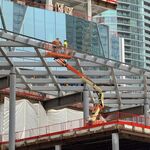Coltaine79
Active Member
I'd like to wall mount my LCD TV (46") to one of the walls of my living room. Problem is, both of the walls are unit separation
walls. I assume that they must be drywall on concrete, but various people I've talked to have given me various other possibilities.
Talking to the property manager did not help much, although she doesn't think the condo board will have a problem with me doing it (which is nice!).
How can I find out what's inside my walls (without breaking them down)? if it matters, my condo is Monarch-built, from the early 2000's, in North York. 24 storey building, from the outside it looks like it's concrete and glass.
walls. I assume that they must be drywall on concrete, but various people I've talked to have given me various other possibilities.
Talking to the property manager did not help much, although she doesn't think the condo board will have a problem with me doing it (which is nice!).
How can I find out what's inside my walls (without breaking them down)? if it matters, my condo is Monarch-built, from the early 2000's, in North York. 24 storey building, from the outside it looks like it's concrete and glass.




